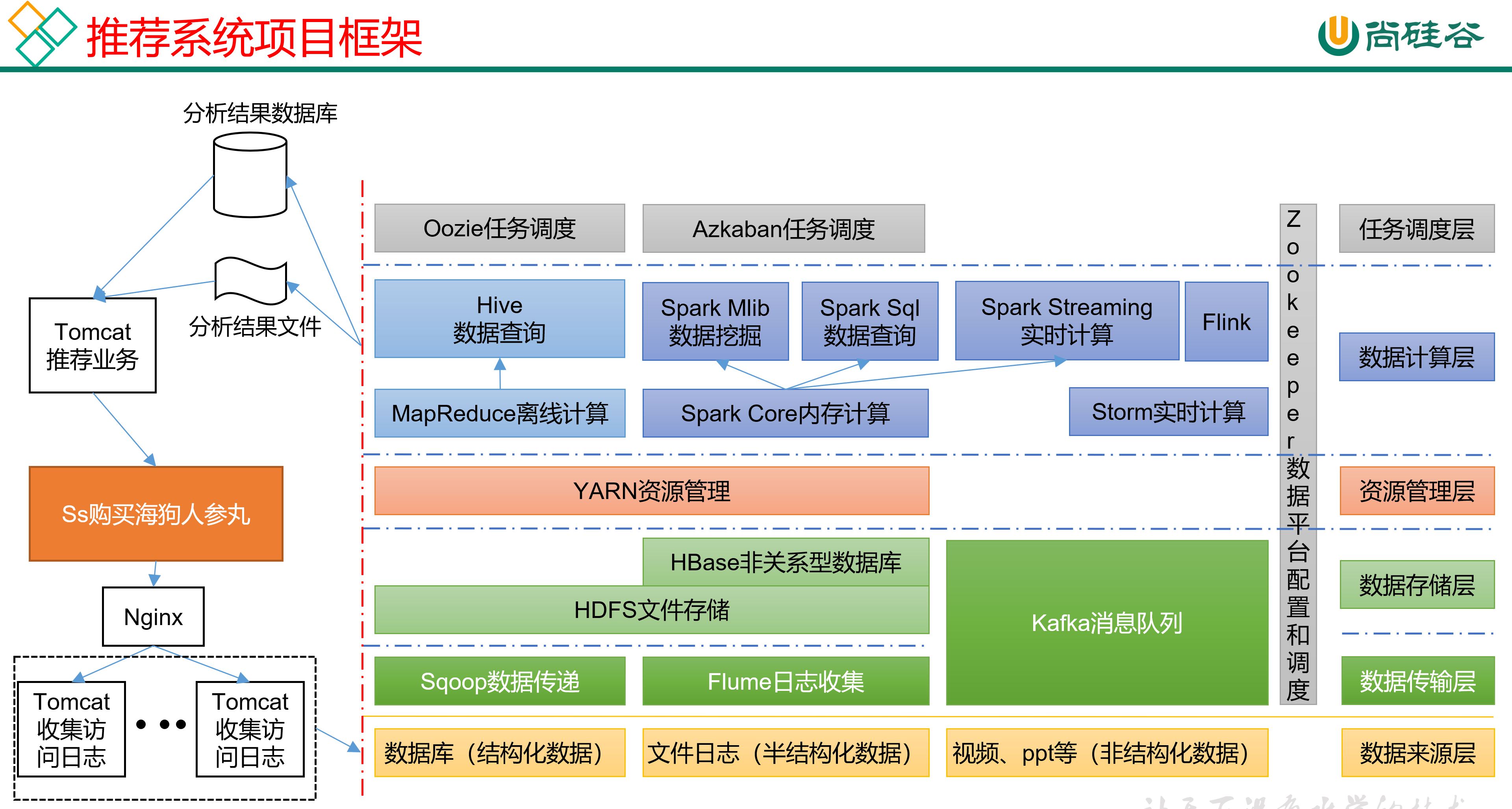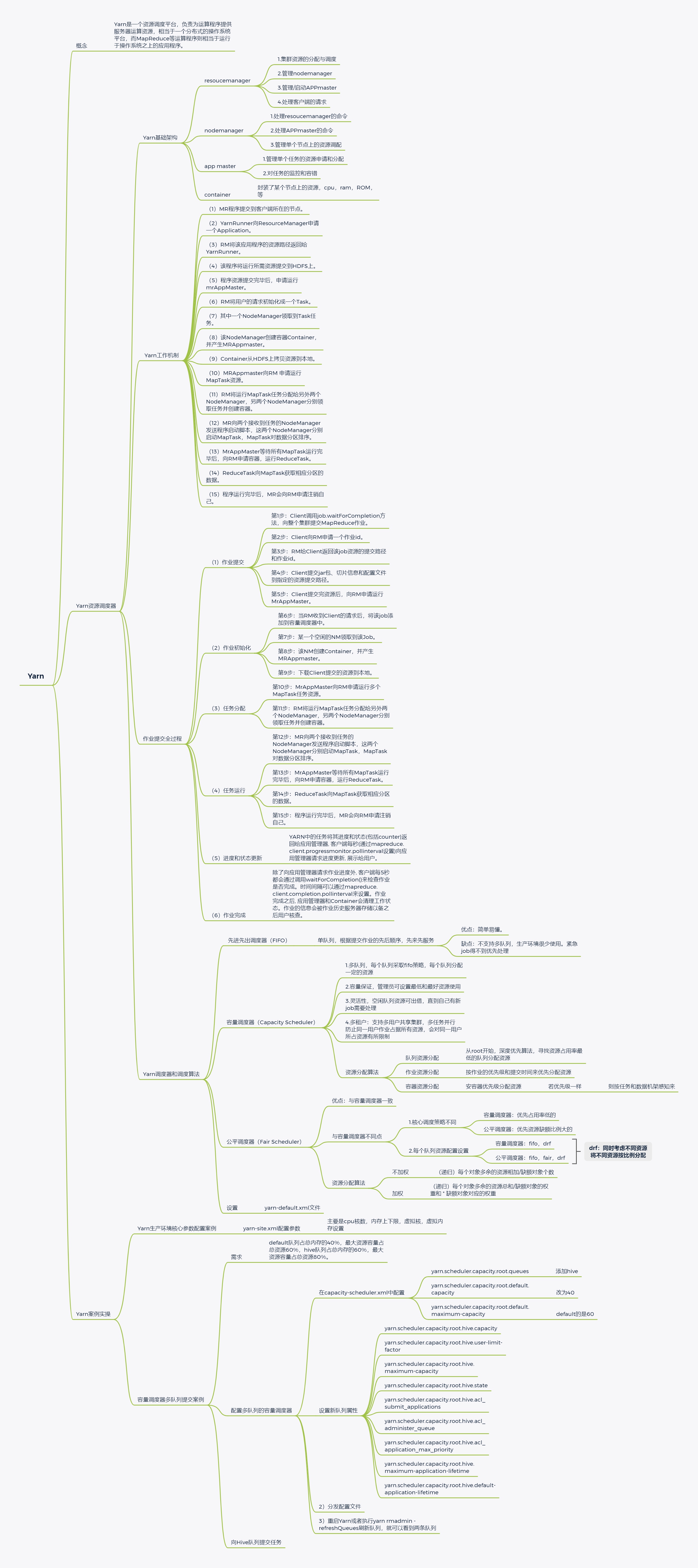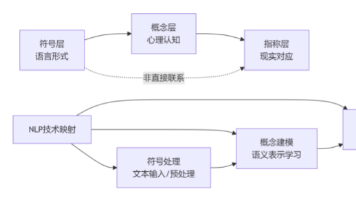大数据-Hadoop-YARN:资源调度器【YARN负责为运算程序提供服务器运算资源,相当于一个分布式的操作系统平台,而MapReduce等运算程序则相当于运行于操作系统之上的应用程序】
需求1:default队列占总内存的40%,最大资源容量占总资源60%,hive队列占总内存的60%,最大资源容量占总资源80%。1)需求:从1G数据中,统计每个单词出现次数。服务器3台,每台配置4G内存,4核CPU,4线程。是一个资源调度平台,负责为运算程序提供服务器运算资源,相当于一个分布式的。)因为担心员工不小心,写递归死循环代码,把所有资源全部耗尽。每个框架的任务放入指定的队列(企业用的不

第1章 Yarn资源调度器
思考:
1)如何管理集群资源?
2)如何给任务合理分配资源?
Yarn是一个资源调度平台,负责为运算程序提供服务器运算资源,相当于一个分布式的操作系统平台,而MapReduce等运算程序则相当于运行于操作系统之上的应用程序。
1.1 Yarn基础架构
YARN主要由ResourceManager、NodeManager、ApplicationMaster和Container等组件构成。
1.2 Yarn工作机制
(1)MR程序提交到客户端所在的节点。
(2)YarnRunner向ResourceManager申请一个Application。
(3)RM将该应用程序的资源路径返回给YarnRunner。
(4)该程序将运行所需资源提交到HDFS上。
(5)程序资源提交完毕后,申请运行mrAppMaster。
(6)RM将用户的请求初始化成一个Task。
(7)其中一个NodeManager领取到Task任务。
(8)该NodeManager创建容器Container,并产生MRAppmaster。
(9)Container从HDFS上拷贝资源到本地。
(10)MRAppmaster向RM 申请运行MapTask资源。
(11)RM将运行MapTask任务分配给另外两个NodeManager,另两个NodeManager分别领取任务并创建容器。
(12)MR向两个接收到任务的NodeManager发送程序启动脚本,这两个NodeManager分别启动MapTask,MapTask对数据分区排序。
(13)MrAppMaster等待所有MapTask运行完毕后,向RM申请容器,运行ReduceTask。
(14)ReduceTask向MapTask获取相应分区的数据。
(15)程序运行完毕后,MR会向RM申请注销自己。
1.3 作业提交全过程
作业提交全过程详解
(1)作业提交
第1步:Client调用job.waitForCompletion方法,向整个集群提交MapReduce作业。
第2步:Client向RM申请一个作业id。
第3步:RM给Client返回该job资源的提交路径和作业id。
第4步:Client提交jar包、切片信息和配置文件到指定的资源提交路径。
第5步:Client提交完资源后,向RM申请运行MrAppMaster。
(2)作业初始化
第6步:当RM收到Client的请求后,将该job添加到容量调度器中。
第7步:某一个空闲的NM领取到该Job。
第8步:该NM创建Container,并产生MRAppmaster。
第9步:下载Client提交的资源到本地。
(3)任务分配
第10步:MrAppMaster向RM申请运行多个MapTask任务资源。
第11步:RM将运行MapTask任务分配给另外两个NodeManager,另两个NodeManager分别领取任务并创建容器。
(4)任务运行
第12步:MR向两个接收到任务的NodeManager发送程序启动脚本,这两个NodeManager分别启动MapTask,MapTask对数据分区排序。
第13步:MrAppMaster等待所有MapTask运行完毕后,向RM申请容器,运行ReduceTask。
第14步:ReduceTask向MapTask获取相应分区的数据。
第15步:程序运行完毕后,MR会向RM申请注销自己。
(5)进度和状态更新
YARN中的任务将其进度和状态(包括counter)返回给应用管理器, 客户端每秒(通过mapreduce.client.progressmonitor.pollinterval设置)向应用管理器请求进度更新, 展示给用户。
(6)作业完成
除了向应用管理器请求作业进度外, 客户端每5秒都会通过调用waitForCompletion()来检查作业是否完成。时间间隔可以通过mapreduce.client.completion.pollinterval来设置。作业完成之后, 应用管理器和Container会清理工作状态。作业的信息会被作业历史服务器存储以备之后用户核查。
1.4 Yarn调度器和调度算法
目前,Hadoop作业调度器主要有三种:FIFO、容量(Capacity Scheduler)和公平(Fair Scheduler)。Apache Hadoop3.1.3默认的资源调度器是Capacity Scheduler。
CDH框架默认调度器是Fair Scheduler。
具体设置详见:yarn-default.xml文件
<property>
<description>The class to use as the resource scheduler.</description>
<name>yarn.resourcemanager.scheduler.class</name>
<value>org.apache.hadoop.yarn.server.resourcemanager.scheduler.capacity.CapacityScheduler</value>
</property>
1.4.1 先进先出调度器(FIFO)
FIFO调度器(First In First Out):单队列,根据提交作业的先后顺序,先来先服务。
优点:简单易懂。
缺点:不支持多队列,生产环境很少使用。
1.4.2 容量调度器(Capacity Scheduler)
Capacity Scheduler是Yahoo开发的多用户调度器。
1.4.3 公平调度器(Fair Scheduler)
Fair Schedulere是Facebook开发的多用户调度器。
第2章 Yarn案例实操
注:调整下列参数之前尽量拍摄Linux快照,否则后续的案例,还需要重新准备集群。
2.1 Yarn生产环境核心参数配置案例
1)需求:从1G数据中,统计每个单词出现次数。服务器3台,每台配置4G内存,4核CPU,4线程。
2)需求分析:
1G / 128m = 8个MapTask;1个ReduceTask;1个mrAppMaster
平均每个节点运行10个 / 3台 ≈ 3个任务(4 3 3)
3)修改yarn-site.xml配置参数如下:
<!-- 选择调度器,默认容量 -->
<property>
<description>The class to use as the resource scheduler.</description>
<name>yarn.resourcemanager.scheduler.class</name>
<value>org.apache.hadoop.yarn.server.resourcemanager.scheduler.capacity.CapacityScheduler</value>
</property>
<!-- ResourceManager处理调度器请求的线程数量,默认50;如果提交的任务数大于50,可以增加该值,但是不能超过3台 * 4线程 = 12线程(去除其他应用程序实际不能超过8) -->
<property>
<description>Number of threads to handle scheduler interface.</description>
<name>yarn.resourcemanager.scheduler.client.thread-count</name>
<value>8</value>
</property>
<!--
是否将虚拟核数当作CPU核数,默认是false,采用物理CPU核数
-->
<property>
<description>Flag to determine if logical processors(such as
hyperthreads) should be counted as cores. Only applicable on Linux
when yarn.nodemanager.resource.cpu-vcores is set to -1 and
yarn.nodemanager.resource.detect-hardware-capabilities is true.
</description>
<name>yarn.nodemanager.resource.count-logical-processors-as-cores</name>
<value>false</value>
</property>
<!-- 是否让yarn自动检测硬件进行配置,默认是false,如果该节点有很多其他应用程序,建议手动配置。如果该节点没有其他应用程序,可以采用自动 -->
<property>
<description>Enable auto-detection of node capabilities such as
memory and CPU.
</description>
<name>yarn.nodemanager.resource.detect-hardware-capabilities</name>
<value>false</value>
</property>
<!--
Core转成Vcore的个数(虚拟核数和物理核数乘数,默认是1.0)
hadoop中的vcore不是真正的core,通常vcore的个数设置为逻辑cpu个数的1~5倍。
-->
<property>
<description>Multiplier to determine how to convert phyiscal cores to vcores. This value is used if
yarn.nodemanager.resource.cpu-vcores is set to -1(which implies auto-calculate vcores) and
yarn.nodemanager.resource.detect-hardware-capabilities is set to true. The number of vcores will be calculated as number of CPUs * multiplier.
</description>
<name>yarn.nodemanager.resource.pcores-vcores-multiplier</name>
<value>1.0</value>
</property>
<!-- NodeManager使用内存数,默认8G,修改为4G内存 -->
<property>
<description>Amount of physical memory, in MB, that can be allocated
for containers. If set to -1 and
yarn.nodemanager.resource.detect-hardware-capabilities is true, it is
automatically calculated(in case of Windows and Linux).
In other cases, the default is 8192MB.
</description>
<name>yarn.nodemanager.resource.memory-mb</name>
<value>4096</value>
</property>
<!-- nodemanager的CPU核数,不按照硬件环境自动设定时默认是8个,修改为4个 -->
<property>
<description>Number of vcores that can be allocated
for containers. This is used by the RM scheduler when allocating
resources for containers. This is not used to limit the number of
CPUs used by YARN containers. If it is set to -1 and
yarn.nodemanager.resource.detect-hardware-capabilities is true, it is
automatically determined from the hardware in case of Windows and Linux.
In other cases, number of vcores is 8 by default.</description>
<name>yarn.nodemanager.resource.cpu-vcores</name>
<value>4</value>
</property>
<!-- 容器最小内存,默认1G -->
<property>
<description>The minimum allocation for every container request at the RM in MBs. Memory requests lower than this will be set to the value of this property. Additionally, a node manager that is configured to have less memory than this value will be shut down by the resource manager.
</description>
<name>yarn.scheduler.minimum-allocation-mb</name>
<value>1024</value>
</property>
<!-- 容器最大内存,默认8G,修改为2G -->
<property>
<description>The maximum allocation for every container request at the RM in MBs. Memory requests higher than this will throw an InvalidResourceRequestException.
</description>
<name>yarn.scheduler.maximum-allocation-mb</name>
<value>2048</value>
</property>
<!-- 容器最小CPU核数,默认1个 -->
<property>
<description>The minimum allocation for every container request at the RM in terms of virtual CPU cores. Requests lower than this will be set to the value of this property. Additionally, a node manager that is configured to have fewer virtual cores than this value will be shut down by the resource manager.
</description>
<name>yarn.scheduler.minimum-allocation-vcores</name>
<value>1</value>
</property>
<!-- 容器最大CPU核数,默认4个,修改为2个 -->
<property>
<description>The maximum allocation for every container request at the RM in terms of virtual CPU cores. Requests higher than this will throw an
InvalidResourceRequestException.</description>
<name>yarn.scheduler.maximum-allocation-vcores</name>
<value>2</value>
</property>
<!-- 虚拟内存检查,默认打开,修改为关闭 -->
<property>
<description>Whether virtual memory limits will be enforced for
containers.</description>
<name>yarn.nodemanager.vmem-check-enabled</name>
<value>false</value>
</property>
<!-- 虚拟内存和物理内存设置比例,默认2.1 -->
<property>
<description>Ratio between virtual memory to physical memory when setting memory limits for containers. Container allocations are expressed in terms of physical memory, and virtual memory usage is allowed to exceed this allocation by this ratio.
</description>
<name>yarn.nodemanager.vmem-pmem-ratio</name>
<value>2.1</value>
</property>
4)分发配置
注意:如果集群的硬件资源不一致,要每个NodeManager单独配置。
5)重启集群
[atguigu@hadoop102 hadoop-3.1.3]$ sbin/stop-yarn.sh
[atguigu@hadoop103 hadoop-3.1.3]$ sbin/start-yarn.sh
6)执行WordCount程序
[atguigu@hadoop102 hadoop-3.1.3]$ hadoop jar share/hadoop/mapreduce/hadoop-mapreduce-examples-3.1.3.jar wordcount /input /output
7)观察Yarn任务执行页面
http://hadoop103:8088/cluster/apps
2.2 容量调度器多队列提交案例
1)在生产环境怎么创建队列?
(1)调度器默认就1个default队列,不能满足生产要求。
(2)按照框架:hive /spark/ flink 每个框架的任务放入指定的队列(企业用的不是特别多)。
(3)按照业务模块:登录注册、购物车、下单、业务部门1、业务部门2。
2)创建多队列的好处?
(1)因为担心员工不小心,写递归死循环代码,把所有资源全部耗尽。
(2)实现任务的降级使用,特殊时期保证重要的任务队列资源充足。11.11 6.18
业务部门1(重要)=》业务部门2(比较重要)=》下单(一般)=》购物车(一般)=》登录注册(次要)。
2.2.1 需求
需求1:default队列占总内存的40%,最大资源容量占总资源60%,hive队列占总内存的60%,最大资源容量占总资源80%。
2.2.2 配置多队列的容量调度器
1)在capacity-scheduler.xml中配置如下
(1)修改如下配置
<!-- 指定多队列,增加hive队列 -->
<property>
<name>yarn.scheduler.capacity.root.queues</name>
<value>default,hive</value>
<description>
The queues at the this level (root is the root queue).
</description>
</property>
<!-- 降低default队列资源额定容量为40%,默认100% -->
<property>
<name>yarn.scheduler.capacity.root.default.capacity</name>
<value>40</value>
</property>
<!-- 降低default队列资源最大容量为60%,默认100% -->
<property>
<name>yarn.scheduler.capacity.root.default.maximum-capacity</name>
<value>60</value>
</property>
(2)为新加队列添加必要属性
<!-- 指定hive队列的资源额定容量 -->
<property>
<name>yarn.scheduler.capacity.root.hive.capacity</name>
<value>60</value>
</property>
<!-- 用户最多可以使用队列多少资源,1表示所有 -->
<property>
<name>yarn.scheduler.capacity.root.hive.user-limit-factor</name>
<value>1</value>
</property>
<!-- 指定hive队列的资源最大容量 -->
<property>
<name>yarn.scheduler.capacity.root.hive.maximum-capacity</name>
<value>80</value>
</property>
<!-- 启动hive队列 -->
<property>
<name>yarn.scheduler.capacity.root.hive.state</name>
<value>RUNNING</value>
</property>
<!-- 哪些用户有权向队列提交作业 -->
<property>
<name>yarn.scheduler.capacity.root.hive.acl_submit_applications</name>
<value>*</value>
</property>
<!-- 哪些用户有权操作队列,管理员权限(查看/杀死) -->
<property>
<name>yarn.scheduler.capacity.root.hive.acl_administer_queue</name>
<value>*</value>
</property>
<!-- 哪些用户有权配置提交任务优先级 -->
<property>
<name>yarn.scheduler.capacity.root.hive.acl_application_max_priority</name>
<value>*</value>
</property>
<!-- 任务的超时时间设置:yarn application -appId appId -updateLifetime Timeout
参考资料:Enforcing application lifetime SLAs on YARN - Cloudera Blog -->
<!-- 如果application指定了超时时间,则提交到该队列的application能够指定的最大超时时间不能超过该值。
-->
<property>
<name>yarn.scheduler.capacity.root.hive.maximum-application-lifetime</name>
<value>-1</value>
</property>
<!-- 如果application没指定超时时间,则用default-application-lifetime作为默认值 -->
<property>
<name>yarn.scheduler.capacity.root.hive.default-application-lifetime</name>
<value>-1</value>
</property>
2)分发配置文件
3)重启Yarn或者执行yarn rmadmin -refreshQueues刷新队列,就可以看到两条队列
[atguigu@hadoop102 hadoop-3.1.3]$ yarn rmadmin -refreshQueues
2.2.3 向Hive队列提交任务
1)hadoop jar的方式
[atguigu@hadoop102 hadoop-3.1.3]$ hadoop jar share/hadoop/mapreduce/hadoop-mapreduce-examples-3.1.3.jar wordcount -D mapreduce.job.queuename=hive /input /output
注: -D表示运行时改变参数值
2)打jar包的方式
默认的任务提交都是提交到default队列的。如果希望向其他队列提交任务,需要在Driver中声明:
public class WcDrvier {
public static void main(String[] args) throws IOException, ClassNotFoundException, InterruptedException {
Configuration conf = new Configuration();
conf.set("mapreduce.job.queuename","hive");
//1. 获取一个Job实例
Job job = Job.getInstance(conf);
。。。 。。。
//6. 提交Job
boolean b = job.waitForCompletion(true);
System.exit(b ? 0 : 1);
}
}
这样,这个任务在集群提交时,就会提交到hive队列:
更多推荐
 已为社区贡献165条内容
已为社区贡献165条内容










所有评论(0)